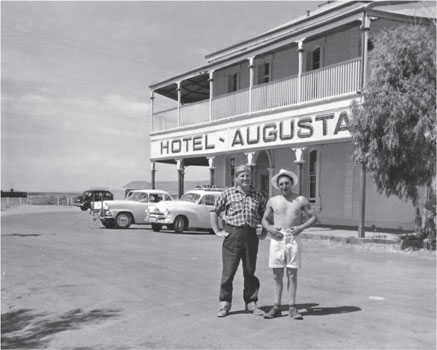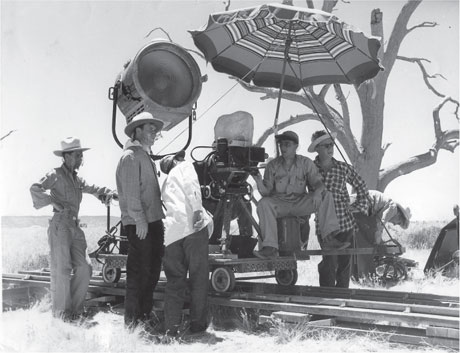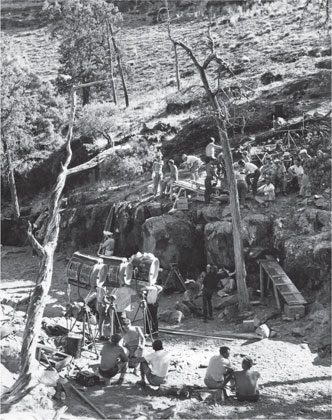Shooting 007: And Other Celluloid Adventures (11 page)
Read Shooting 007: And Other Celluloid Adventures Online
Authors: Sir Roger Moore Alec Mills

I have no intention of going into what or who we saw through the car window that night, but in that short time I sensed a troubled, lost expression on his face. This happened so fleetingly that one might question how we could take all this in. I don’t know; I cannot answer that. These were our feelings at that moment and to this day neither Lesley nor I would change our minds on this matter.
I questioned whether I should mention this experience in these memoirs, knowing the reaction of doubters on such matters, but with Lesley also seeing the apparition before us we can both bear witness to the moment. Whether Lesley sensed that ‘lost’ look on the old man’s face is not something I recall talking about; even so, this incident should be recorded because it really happened. It was some years later that I watched a television programme about the paranormal where Arthur C. Clarke, the well-known science fiction author, claimed that it was rare for two people to see a ghost at the same time. Well, Arthur, Lesley and I did, and both of us would swear to it happening; as for me, the experience would leave many questions unanswered about the afterlife – if there is such a thing.
I accept that many will find this subject difficult to understand, particularly with reference to the afterlife, but as with all strange events they fade over time, sometimes to the point where you end up doubting your own sanity. This might also have been doubted when I volunteered for the navy, as I stubbornly refused to listen to good counsel when advised to think twice about my decision – no chance, with my obstinate personality! Could this be a peculiarity in my character, shaping my fate? Whatever the deal was, in the future I would keep an open mind on unexplained events that made little sense, and I would be reunited with Harry Waxman – or could it be that I was ‘destined’ to work with him? It would seem that we were fated to share a part of the long journey together.
Harry’s next challenge,
Robbery Under Arms,
brings back memories courtesy of the Rank Organisation, which had decided to send their camera crews around the world – genuine locations for reality, we were told. The film industry was entering exciting times and Harry and crew were flying off to Australia. The long flight to Down Under would find us stopping off at many countries along the way before finally reaching Darwin, where we first experienced the big change in temperature. Our next stop was Alice Springs in the heart of Australia, where the humidity becomes even higher. On opening the cabin door a buzzing black cloud entered our temporary habitat as billions of flies moved in to explore our transitory home. The excitement of visiting Australia was fast losing its appeal and there was one more stop still to come before we reached our destination.

The Hotel Augusta. We stayed in this dump overnight, where the rowdy ranchers got drunk, boasting to see who could drink more and stay upright. I didn’t get much sleep, trying to keep track of the huge spiders in my room. The next day we headed for the outback, where the accommodation was even more basic.
Close to the Flinders mountain ranges, Port Augusta was then a small town in South Australia, where one was reminded of a small settlement as portrayed in American cowboy films. I stayed overnight in what was laughingly called a hotel due to the fact that it had one bedroom available for a weary traveller passing that way. The small box room had a high ceiling with all four corners housing large cobwebs probably spun over many years; the well-entrenched spiders probably resented my presence. The rowdy Aussies in the saloon bar next to my room did not help matters, with their boisterous challenges to see who could stay on their feet the longest.
The next day we moved to our final destination, where our tenancy resembled an old rundown holiday camp. The local Aboriginals had managed to tidy up it before our arrival, though it was still obvious that the place had not been used for some time. Suddenly, we found ourselves trapped in the middle of nowhere for the next six weeks, with little to do after a day’s filming; our isolation was complete. The excitement of foreign travel and the glamour of filming were fast losing their appeal as we sweated in the daytime heat in the unpleasant surroundings. Should any comfort come from all this it was that
Robbery
had taken me to the other side of the world, even if it aroused little desire to return to this vast continent.
With nothing to do after the day’s filming, Bert Batt, the assistant director, attempted to relieve the monotony by tinkling on a dusty old upright piano which had seen better days. I would try to help Bert out, suffering its dreadful tone – not helped with the odd key missing here and there – but at least the unit appreciated these attempts to break up the boredom with a little light entertainment. Harry, for reasons known only to him, appeared to resent these social activities; recognising the signs, I decided to pull back from helping Bert. It seemed that the endless heat was having a strange effect on Harry’s frame of mind, somehow affecting his attitude. Every day I would learn something new about the guv – some good, some bad – but nothing would change my attitude towards him.

While filming on
Robbery Under Arms
one of our Aboriginal trackers who knew how to handle a bullwhip boasted that he could remove the cigarette from my mouth without touching me – even though I didn’t smoke. I was shaking like a leaf but fortunately it was no idle boast. Not surprisingly, I kept my eyes shut!
Although set in Australia,
Robbery Under Arms
was an interesting story similar to the early American cowboy films with armed gangs holding up stagecoaches. Peter Finch enjoyed the lead role of Captain Starlight, the gentleman cattle rustler/bank robber; the supporting cowboys were Ronald Lewis, Laurence Naismith and David McCallum, not forgetting the pretty Jill Ireland and Maureen Swanson, all under the baton of director Jack Lee.
The director’s homework had probably been based on American cowboy films, one of which may have been
Stagecoach
with John Wayne. I mention
Stagecoach
as the film features a well-known scene with a carriage pulled by four horses galloping hard to outrun a hold-up, probably helped with a little under-cranking with the camera, seen from the coach driver’s point of view. Our film also required a four-horse coach to evade the hold-ups featured in the story. Although action scenes like this are exciting to watch – sweating horses with a swaying coach, noise and dust adding to the drama – they can be dangerous to film and so inevitably take time to organise and set up, usually ending as a second-unit sequence. However, our director decided that we would recreate this drama ourselves for his robbery, without a second unit …

One of our more reliable vehicles in the Australian bush, and a perfect opportunity for the Keystone Camera Crew to pose for an unusual unit still.

From left to right: the grip, Ronnie Anscombe (clapper loader) with me seated beneath the parasol on the camera dolly. Harry Waxman leans in the background, wearing the checked shirt.
Perhaps I should briefly explain the term ‘second unit’, which usually works with doubles for the action sequences which take time and money with its preparation. These technicians are experts in their own field and their work usually fits seamlessly into the scenes already filmed by the first unit – or vice versa.
Our stagecoach was loaned from a museum and had the usual handrail on top where luggage would normally be stowed. This was to be my position, from where I could support the camera operator Jimmy Bawden, who was safely strapped down next to the driver. With Jimmy in position, I put one reassuring arm around his waist to give extra support – for him and for me – while at the same time my other hand held on to the luggage rack to aid my own security.
Off we went with everything going well for a minute or so, when suddenly the swaying movement of the coach started to increase. No longer was it possible to support Jimmy, whom I knew was safely strapped to his seat; it was now time to think more about my own survival. Our filming suddenly bordered on madness as I was paralysed, unable to move, holding on to anything available. All the time I retained my faith in the driver’s skills, his expertise – none of which appeared to be forthcoming – and still no signal yet to abandon ship!

